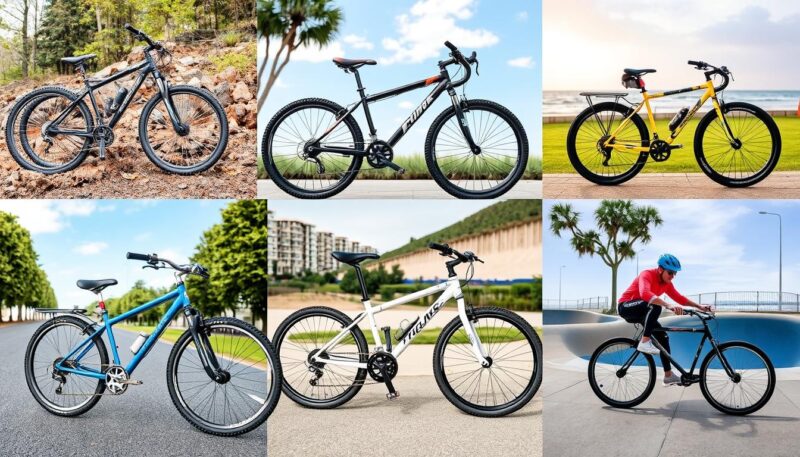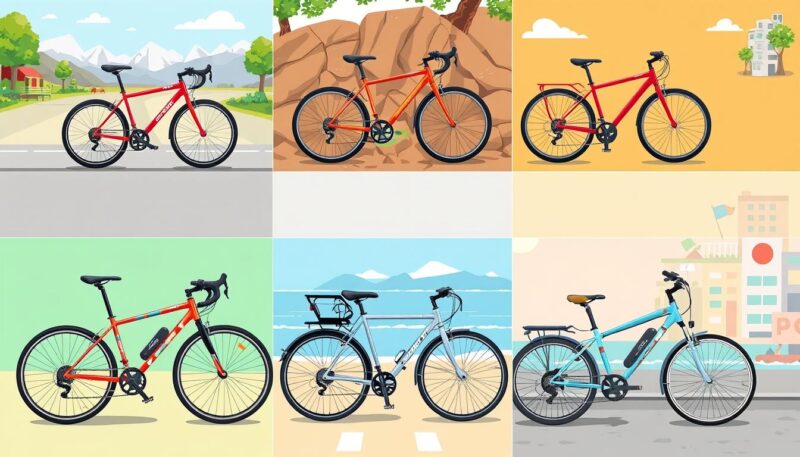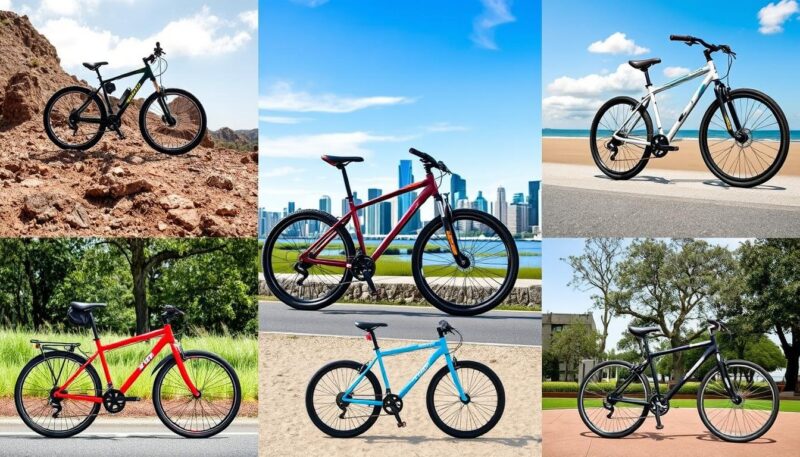Choosing the right bicycle can feel overwhelming, especially given the plethora of options available on the market today. Whether you are a seasoned cyclist or just starting on your biking journey, it’s crucial to understand different bike types to find the one that best aligns with your riding style and adventure needs. This bike selection guide will break down various categories of bicycles, including road, mountain, gravel, hybrid, and electric bikes, and provide invaluable insights into their specific uses and benefits. By the end of this guide, you’ll have a clearer vision of how to select a bike that complements your lifestyle and preferences.
As you navigate this guide, remember that every type of bike serves a unique purpose. For example, road bikes are designed for speed and efficiency on smooth pavement, while mountain bikes excel in rugged terrains and trails. This variety means there is a perfect bike for every rider, but understanding the nuances is key to making an informed decision. If you find yourself daydreaming about weekend adventures or commuting through city streets, the right bike can enhance your experience significantly.
In the sections that follow, we will delve deeper into the specifics of each bike type, helping you assess your goals, experience level, and comfort preferences. So, if you’re ready to learn about understanding different bike types and how to select the perfect match for your riding ambitions, let’s get started!
Types of Bikes Explained
Understanding the different kinds of bikes and their uses can help you choose the best option for your cycling journey. Let’s explore the various bike types explained in detail.
Road Bikes
Road bikes are engineered for speed on smooth pavement. With lightweight frames, skinny tires, and aerodynamic designs, these bikes excel in racing and long-distance rides. Variations within this category include endurance bikes for comfort, climbing bikes for steep ascents, and aero bikes focused on speed. Each design serves specific cycling needs, making them popular among enthusiasts.
Mountain Bikes
Mountain bikes tackle rough, rugged terrains with features like wider tires and knobby tread patterns for enhanced traction. They come in various types, including hardtail bikes with front suspension for basic trails and full-suspension bikes for advanced off-road experiences. Offering versatility for steep descents and technical obstacles, mountain bikes are ideal for adventurous riders seeking outdoor challenges.
Hybrid/Commuter Bikes
Hybrid bikes blend attributes of road and mountain bikes, making them versatile for diverse riding conditions. Their flat handlebars and comfortable seating positions make them suitable for urban commuting and light trail riding. This adaptability caters to casual cyclists and practical commuters alike, making hybrid bikes a popular choice.
Gravel/Adventure Bikes
Gravel bikes combine the efficiency of road biking with the rugged capabilities of mountain biking. Fitted with wider tires ranging from 1.26 to 1.73 inches, they provide comfort on varied terrains. These bikes are ideal for long-distance rides, touring, and bikepacking adventures, appealing to cyclists who enjoy exploring multiple environments.
Electric Bikes
Electric bikes, or e-bikes, feature integrated electric motors to aid pedaling, making cycling more accessible for all fitness levels. Available in styles such as hybrid and mountain, they allow riders to conquer longer distances and challenging routes effortlessly. E-bikes are increasingly popular, catering to those looking for an enhanced riding experience.
Specialty Bikes (e.g., BMX, Fat Bikes)
Specialty bikes serve niche purposes, offering unique features for specific activities. BMX bikes are designed for tricks and racing and are available in suitable variations for different skill levels. Fat bikes cater to off-road experiences on snow and sand, while tandem bikes accommodate two riders, and recumbent bikes offer a laid-back riding position. Each type fulfills distinct cycling needs.
| Bike Type | Key Features | Best Use |
|---|---|---|
| Road Bikes | Lightweight, skinny tires, drop handlebars | Racing, long distances on paved roads |
| Mountain Bikes | Wider tires, knobby tread, durable frame | Off-road trails, rocky terrains |
| Hybrid/Commuter Bikes | Flat handlebars, comfortable seating | Urban commuting, light trail rides |
| Gravel Bikes | Wider tires, comfortable geometry | Long-distance touring, bikepacking |
| Electric Bikes | Motor-assisted pedaling | Effortless commuting, diverse terrains |
| Specialty Bikes | Variants for BMX, fat biking, etc. | Tricks, racing, niche cycling activities |
Choosing the Right Bike for Your Riding Style
Selecting the perfect bicycle involves understanding various factors that align with your specific needs and preferences. By clarifying your riding goals, assessing your experience level, and ensuring proper comfort and fit, you can make informed decisions regarding bike types for beginners and advanced cyclists alike.
Understanding Your Riding Goals
Begin by defining how you intend to use your bike. Will it be for daily commuting, leisurely rides, or competitive racing? Identifying your primary use can streamline the process of choosing the right bike for your riding style. For instance, road bikes excel in speed and efficiency on paved surfaces while mountain bikes are ideal for off-road adventures.
Assessing Experience Level
Your level of riding experience is essential when selecting the right bike. If you’re a beginner, opting for hybrid bikes or stable road bikes often makes for a more enjoyable ride. These bike types for beginners typically offer excellent balance and ease of handling. More seasoned riders can explore advanced options like high-performance mountain or specialized road bikes for an enhanced cycling experience.
Considering Comfort and Fit
Prioritize comfort when choosing your bike, especially for longer rides. Look out for components such as frame size, handlebar height, and saddle comfort. Each element affects how well the bike accommodates your body type and riding style. A test ride can provide valuable insight into the bike’s fit, helping ensure a pleasant experience during your cycling journey.

| Riding Goals | Recommended Bike Types |
|---|---|
| Commuting | Hybrid, Electric |
| Leisure | Cruiser, Hybrid |
| Racing | Road, Triathlon |
| Off-road Adventures | Mountain, Fat |
Understanding Different Bike Types
Exploring the array of bike types available allows you to match your specific needs with the right bicycle. Each bike type is constructed with unique features designed for different riding purposes. Familiarizing yourself with bike types explained can significantly enhance your biking experience.
Different Kinds of Bikes and Their Uses
Understanding the various kinds of bikes helps you select the one that fits your intended use:
- Road Bikes: Ideal for smooth, paved surfaces, these bikes prioritize speed and efficiency.
- Mountain Bikes: Built tough for rugged trails, these bikes are perfect for off-road adventures.
- Hybrid Bikes: These bicycles combine elements of road and mountain bikes, providing versatility for both commuting and recreational riding.
- Gravel Bikes: Known for their versatility, they navigate pavement and dirt with ease.
- Electric Bikes: Equipped with pedal assistance, these bikes offer ease for commuting and longer rides.
- Specialty Bikes: Options like BMX, fat bikes, and recumbent bikes serve various unique purposes.
Benefits of Each Bike Type
Each bike type offers a set of distinct benefits:
- Speed: Road bikes are designed for covering distances quickly.
- Durability: Mountain bikes withstand rugged environments, ideal for more challenging terrains.
- Comfort: Hybrid and cruiser bikes focus on providing a comfortable riding experience.
- Accessibility: Electric bikes help riders of different fitness levels enjoy cycling.
- Versatility: Touring bikes manage longer rides with stability, and gravel bikes excel in varied landscapes.
Price Ranges for Each Category
Understanding the price ranges for each category can help you budget effectively:
| Bike Type | Price Range |
|---|---|
| Road Bikes | $800 – $10,000+ |
| Mountain Bikes | $500 – $10,000+ |
| Hybrid Bikes | $400 – $1,500 |
| Electric Bikes | $1,000 – $8,000 |
| Gravel Bikes | $800 – $3,500 |
| Specialty Bikes | $250 – $2,500 |

Conclusion
Understanding different bike types is crucial for making an informed decision that aligns with your riding style and personal preferences. Each type of bike—from road bikes designed for speed on smooth pavement to mountain bikes engineered for rough terrains—offers unique features that cater to specific needs. If you’re exploring versatility, hybrid bikes merge characteristics from both road and mountain variations, ensuring comfort for general-purpose cycling.
Moreover, electric bikes provide an excellent option for those looking to tackle longer distances without as much physical strain, while gravel bikes let you traverse all terrains with stability. This bike selection guide emphasizes the importance of considering your specific use case, whether that be daily commuting or weekend adventures, as well as your budget, as prices and features can vary significantly.
Ultimately, take the time to explore each type of bicycle available in the market. Don’t hesitate to test ride several options—your perfect ride awaits! By being well-informed and considering what different bike types offer, you can find the ideal match that suits your lifestyle and enhances your cycling experience.






